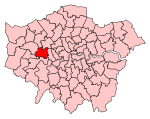Ealing Common tube station

Ealing Common is a London Underground station on the Uxbridge branch of the Piccadilly line and on the Ealing Broadway branch of the District line. Eastbound, the next station is Acton Town; westbound, the next station is North Ealing on the Piccadilly line and Ealing Broadway on the District line. Here, the District and Piccadilly lines share the same pair of tracks through the station – the only other example where a deep level line and a sub surface line share the same pair of tracks is further up the Uxbridge branch, where the Piccadilly line shares tracks with the Metropolitan line from Rayners Lane to Uxbridge. It is the only station west of Acton Town to be served by both the Piccadilly and District lines. The station is located in Ealing on the Uxbridge Road (A4020), about 490 yards (450 m) east of the junction with Gunnersbury Avenue and Hanger Lane (A406, North Circular Road) and the Ealing Common open space the station takes its name from. It is in Travelcard Zone 3.
Excerpt from the Wikipedia article Ealing Common tube station (License: CC BY-SA 3.0, Authors, Images).Ealing Common tube station
Uxbridge Road, London Acton (London Borough of Ealing)
Geographical coordinates (GPS) Address Nearby Places Show on map
Geographical coordinates (GPS)
| Latitude | Longitude |
|---|---|
| N 51.510277777778 ° | E -0.28805555555556 ° |
Address
Ealing Common Station
Uxbridge Road
W5 3NU London, Acton (London Borough of Ealing)
England, United Kingdom
Open on Google Maps







